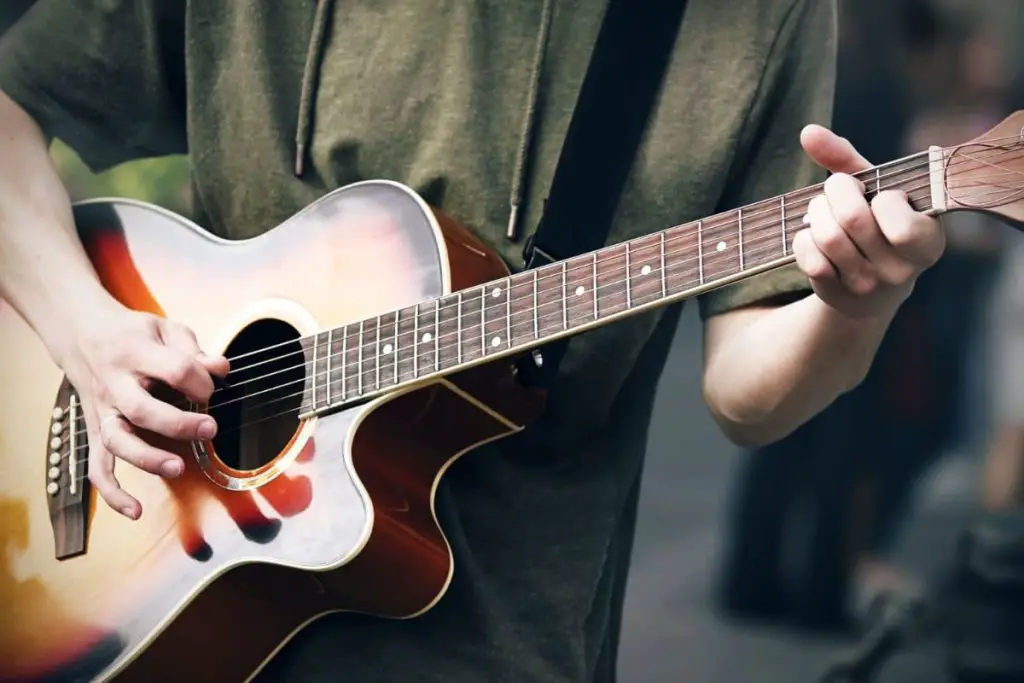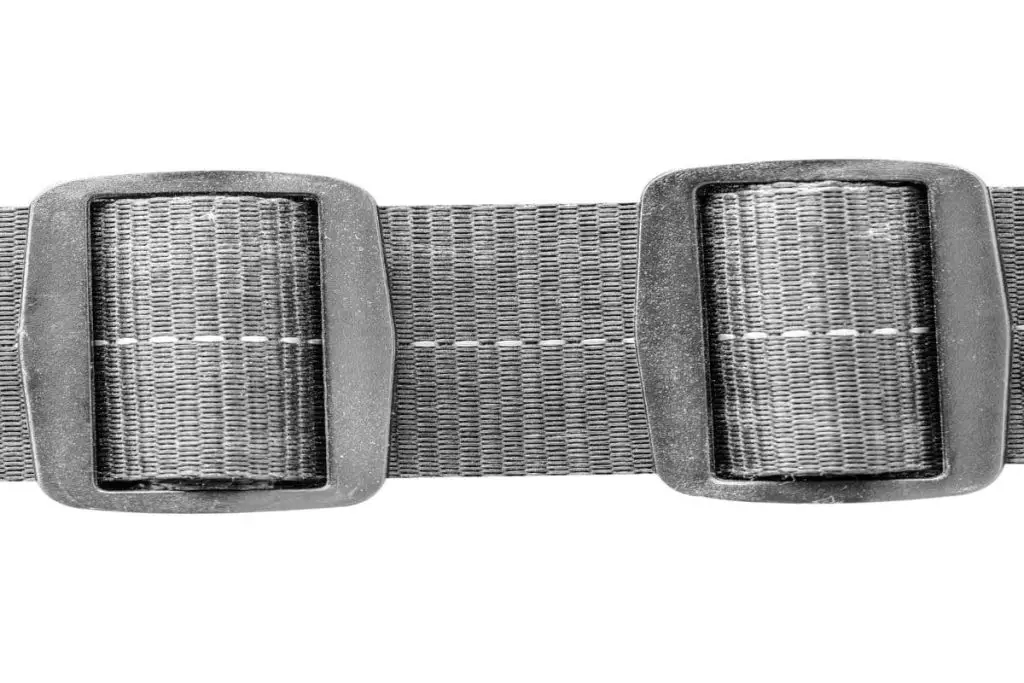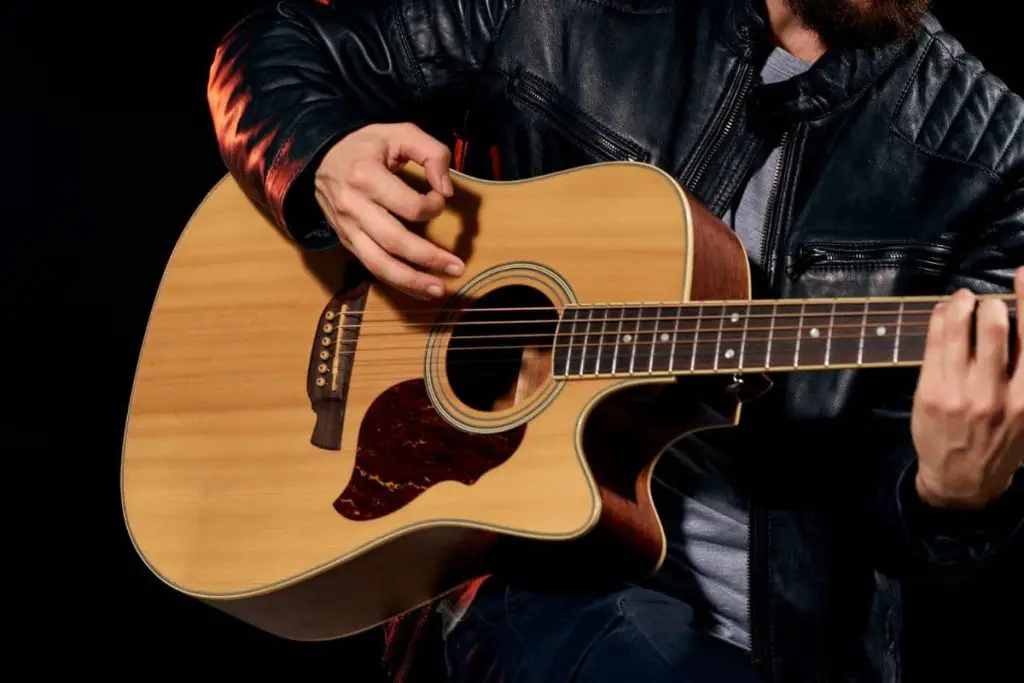Everybody wants to play the guitar, but not many people invest in knowing the correct positions to enhance play quality. An essential part of playing the guitar is knowing how to hold it properly while in live performance. While wielding and strumming the instrument may come easy while seated, it may be a little bit difficult while standing up.
Holding your guitar correctly while standing up makes the difference between a professional and an amateur guitarist. Your guitar strap is vital—including its quality and position while playing. You should also consider your hand positioning to play effectively while standing up.
If you are used to playing your guitar in a seated position, sometimes the transition to standing play may present a challenge. In this article, I will highlight the steps you should take to learn how to hold your guitar correctly when standing. So, if you are looking for a guide—please read on!
If you want to find out what my recommended guitar gear is, then here is what I recommend on Amazon:
- Fender Cutaway Acoustic-Electric Guitar Bundle (MY FAVORITE GUITAR)
- Snark SN-8 Super Tight All Instrument Tuner (Easiest Tuner I’ve Used)
- 6 String Acoustic Guitar Capo (Best CAPO for quick changes)
- Dunlop Max Grip 1.0mm Nylon Picks (Thick Guitar Pick So You Don’t Lose Grip!)
- Universal Guitar Stand (Cheap & Minimalist Guitar Stand I Recommend)
- Levy’s 2″ Wide Quick Adjust Guitar Strap (Best Guitar Strap For Any Level)

How To Hold a Guitar While Standing
Learning to play the guitar while standing is an entirely different experience from playing while seated; however, it is not as hard as you may think. Follow these few simple steps, and you should be ready to jam!
Buy a Quality Strap for Your Guitar
We’ve all watched a guitarist perform, and they all have one thing in common. Whether in a music video or live performance, they have their guitars strapped to their bodies.
A strap is the first step to holding and playing the guitar while standing. Although it may sound obvious, some people still insist on trying to play without strapping their guitars because it ‘does not look cool.’ Nonetheless, such attempts always fail. You cannot hold your guitar and play it simultaneously while standing without strapping it on.
Straps usually come in various designs and colors, making it challenging to choose one. However, while the design you pick solely depends on your taste, ensure the strap you buy is adjustable and made from good quality cloth.
I recommend the LEKATO Bass Guitar Straps (available on Amazon) when planning to strum when standing. The straps are made of memory foam and are easily adjustable for comfort. You can play an hour-long set without your shoulder feeling sore.
You can always fashion it yourself if you are unwilling to purchase a strap. You can make it from almost anything attached to your guitar and allow you to suspend it on your body. Maybe you could use a belt or an old tie.

Attach the Strap to Your Guitar Strap Pegs
What’s the use of having a strap if you are not going to use it? With this in mind, the next step is obviously to attach your strap to your guitar.
However, before making any step, ensure your guitar has strap pegs. Most guitars come with either one or two pre-installed strap pegs, while others don’t. You will usually find these small metal studs extending from the guitar body’s base—if you hold your guitar up vertically.
You can locate the top studs either on the neck of your guitar or where the neck and guitar body intersect. If your instrument does not have one, visit your nearest guitar shop and have one installed.
Alternatively, you could install your strap pegs yourself—here’s a great YouTube tutorial on how to do it:
If your guitar has one strap peg, place the slim end of your strap around the head and under the string where they should attach to the tuning pegs. If they have two pegs, attach either end of the strap to them, and you are ready to play. The pegs are at the top and bottom of the instrument’s body.
Always ensure your straps are firmly attached to the guitar to prevent it from falling off when you play.
Adjust the Strap to Effective Playing Height
Holding and playing the guitar while standing depends on the height you have your instrument.
So, after successfully attaching your strap, sling it over the shoulder of your fretting hand and feel to which level it falls. If the guitar falls to a height you are comfortable playing—you can strum the instrument efficiently. You need to adjust your strap to the palace where you feel you can play freely and adjust the position if it feels uncomfortable.
Generally, rockers and people who play electric guitars love hanging their guitars low. Although they make it look cool when they play like that, the ideal height to have your strapped guitar when you play while standing is around the hip area to allow you to strum easily.
If the guitar hangs too low, you may find it challenging to strum strings since they will be far down. If the instrument is suspended too high, you may tire as you hold up your strumming hand when playing.
Adjust the strap to a height that suits how you are comfortable playing. Remember that you should raise your guitar neck about 30° upwards when playing upright, which may be different from when you play from a seated position.
Reinforce Your Straps With Strap Locks
Your guitar might fall off your strap while playing when standing, which is embarrassing. It might interrupt your performance and, even worse, damage your precious instrument. Since this is something you’d not wish on yourself, you should do everything possible to avoid it.

To avoid such scenarios, reinforce your straps using strap locks.
The locks hold the strap to your guitar and act as a failsafe that prevents your guitar from falling off as you perform. A great choice of strap locks is the Dreokee Guitar Locks from Amazon.com. These locks have end pins that reduce damage to your valuable guitar and are suitable for all guitar types.
Protect your expensive guitar and your reputation.
Secure the Guitar Cable Around Your Strap To Avoid Entangling
If you plan to play the guitar while standing, you will likely be playing with a group of people for an audience. Therefore, you may need to plug in your guitar to increase the sound’s audibility. If not, this step may not be necessary.
Playing with a plugged-in guitar can present various challenges. For example, you may accidentally step on the cable, causing it to fall off and interrupt your playing. If this happens regularly, your input jack could get damaged and loosen over time.
Always wrap the cable around your strap when connecting it to your guitar to enjoy uninterrupted performances and protect it from damage. Securing the cable will prevent it from yanking from the input jack as it will simply pull against the strap when you step on it.
However, despite safeguarding your guitar, you should always be careful not to step on the cable when you play while standing. The constant pressure will eventually damage it.
Play Your Guitar As You Normally Would
Although playing while standing is a whole new experience, the basics of guitar playing remain constant. There is no unique way to strum your guitar while standing than sitting down.
Similarly, the position you hold your guitar does not change. Just as playing while sitting, you must secure the guitar firmly and position it comfortably using your fretting hand. Hold the guitar in a stable position for fretting, giving you room and freedom to strum easily.
If you usually play the guitar with the headstock facing upwards while seated, set up your strap to suspend the guitar in the same position. You could secure your guitar on the strap in a horizontal position. You are good to go if it is at a height where you can comfortably strum and fret.
Hand Placement When Playing Guitar Standing Up
If you have little guitar experience, you may not know how to place your hand correctly. Nonetheless, putting your hands determines how you hold your guitar and whether you play the instrument effectively. Therefore, it is essential to get it right.

Like sitting, you should place your hand on the guitar in specific positions to play the instrument right. The right and left hands have designated positions they should take before you start strumming and playing the instrument.
The Left-Hand Position While Playing Standing Up
Most right-handed guitarists use their left hands to switch between chords. Therefore, your left hand should be placed on the guitar neck and move along the frets. Place your left thumb at the back of the guitar neck while the first two fingers should overlap to the front and rest on the strings.
The fingers at the front are responsible for pressing the string against the fretboard. If you wish to make this process easier, ensure you have short nails that do not get in the way by obstructing the frets.
The positioning of your left hand is not only crucial for fretting but also for placing the guitar in a comfortable position when playing while standing. While the guitar is usually suspended across your body, holding it firmly with your left hand allows you to move it around quickly and find a position you are comfortable playing.
The positioning mentioned above applies to your right hand if you are a left-handed player.
The Right-Hand Position While Playing Standing Up
Once you have correctly placed your fretting hand wielding the guitar, it is pretty simple to position your right hand perfectly. Since the right hand strums the strings, it should be as close as possible to the sound hole.
To hold your guitar correctly, place your upper right arm on the top part of the instrument’s body and pull it close to your body. As the upper arm rests at the top, your hand should suspend over the soundhole to allow you to strum the guitar.
Why Hand Positioning Is Important
Now that we’ve covered how and where to place your hands while playing, you may wonder why learning it is crucial.
Hand positioning is arguably one of the essential parts of playing the guitar while standing. You may have mastered all the chords and strumming techniques, but you cannot use the information if you do not know how to hold your guitar correctly.
Your hand positioning affects a lot of things that determine how you play, including:
- How you strum your guitar.
- The difficulty of fretting and hitting the right chords.
- Comfort while playing the guitar.
Although playing the guitar should be a walk in the park once you have mastered all the chords, improper hand positioning makes it hard since the instrument is in an awkward position.
You need to assume proper hand positioning to play the guitar comfortably. Proper wielding makes playing more manageable and ensures you have an excellent standing posture to prevent back injuries.
Why It Is Important To Learn How To Hold a Guitar While Standing Up
If you conduct a survey and ask most amateur guitarists whether they play their guitars while sitting or standing, it is a safe bet that most of them play while seated. It is easier and more comfortable.
However, once you learn the basic chords and can comfortably play the guitar, you may find yourself in situations where you are required to play the guitar while standing. Perhaps you are out on a training session with acquaintances or auditioning to join a band. If you haven’t learned to play while standing, such circumstances may be uncomfortable.
Similarly, learning to play the guitar while standing may just be what takes you to the next level and separates you from amateur guitarists. If you have been to a concert or music event, you probably have seen the lead guitarists playing while standing and having fun with it. We could all agree that they seemed professional.
Learning to hold and play your guitar while standing has many benefits, including the following:
- Movement: Playing while standing ensures you are portable. You can move around while strumming your guitar and entertain your crowd while performing.
- Rhythm: Strumming your guitar and singing while on your feet gives you a better sense of rhythm. Standing offers breathing advantages that translate into great vocalization. Similarly, you can dance to your tune when standing.
- It is healthy: Playing while standing presents considerable health benefits. It is less straining to your back and helps you burn calories as you move around playing. Maintaining a perfect posture while sitting is hard, so you end up slouching most of the time, which could injure your back.
- It is convenient: Playing while standing saves you from the cost of buying a chair dedicated to practicing the instrument. You can play wherever you are without any stress. It also saves you the hassle of looking for a seat whenever you have to perform outdoors.
Choosing the Right Guitar Strap for Standing Play
There are a range of guitar strap options to pick from, so if you plan to play while standing, you must select the right one. The strap you attach to your guitar determines whether you hold your guitar correctly.

Straps comprise different materials with distinct qualities. If you want a flexible strap, go for one made from material such as nylon, but if you want a stiff and thick one. The strap you choose depends on your preference, but I can give you some pointers to keep in mind when buying one.
- Consider your guitar type. In most cases, the ideal strap depends on your guitar type. Different guitar brands differ in weight and size. If you have a heavy guitar such as a Les Paul, consider getting a broad strap that ensures the instrument’s weight is distributed evenly across your shoulders.
- Consider your strap width. A narrow strap is okay for light guitars but can strain your shoulders and cause spinal injury if you wield a heavy instrument.
- Ensure your comfort in play. If you seek to eliminate stress on your neck and shoulder to enable you to play with ease, you could go for comfort straps. Although they are relatively expensive, comfort straps have cushions that eliminate the pressure from your shoulders when playing in a standing position.
- Your strap should offer adjustability. To further enhance your comfort while playing, always ensure the strap you purchase is adjustable. These straps enable you to tweak the guitar’s position to a height you are comfortable playing.
What Is the Ideal Guitar Size for Playing Standing Up?
Guitar size determines how you hold and play the instrument while standing. If the guitar is excessively large or small, you will struggle to place your hands appropriately and play the instrument. Therefore, you should find a suitably sized guitar for your stature to make holding it look natural.
The ideal guitar size is measured by the position of the elbow of your strumming hand—which should rest between the guitar bridge and the strap button. The rest of the forearm should rest squarely on the guitar body to make it easier to strum the instrument.
If your elbow lands behind the guitar or below its body, the instrument may be the wrong size for you. However, the positioning may change for guitar variants, such as the bass guitar, traditionally wielded at lower heights.
Your elbow functions as a pivot point for strumming your guitar; thus, it needs to be suspended on the guitar body so you can move your arm freely in a downward and upward motion to reach all the guitar strings. This reach is only possible if you have the right guitar size.
Final Thoughts On Holding a Guitar While Standing
Holding a guitar while standing is challenging, primarily if you are used to playing the instrument while seated; however, it is not impossible. All you need is an appropriately sized instrument and aiding equipment such as the right strap.
Once you have those, you should learn how to position your hands on the guitar, master your chords, and you are good to go.
If you want to find out what my recommended guitar gear is, then here is what I recommend on Amazon:
- Fender Cutaway Acoustic-Electric Guitar Bundle (MY FAVORITE GUITAR)
- Snark SN-8 Super Tight All Instrument Tuner (Easiest Tuner I’ve Used)
- 6 String Acoustic Guitar Capo (Best CAPO for quick changes)
- Dunlop Max Grip 1.0mm Nylon Picks (Thick Guitar Pick So You Don’t Lose Grip!)
- Universal Guitar Stand (Cheap & Minimalist Guitar Stand I Recommend)
- Levy’s 2″ Wide Quick Adjust Guitar Strap (Best Guitar Strap For Any Level)

